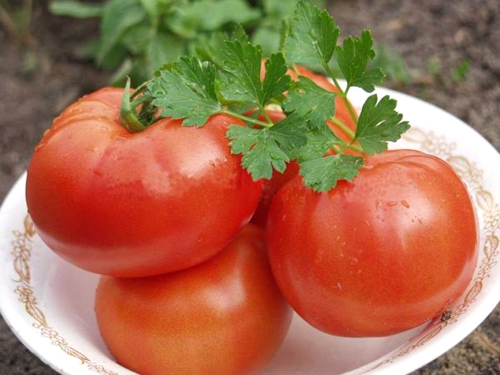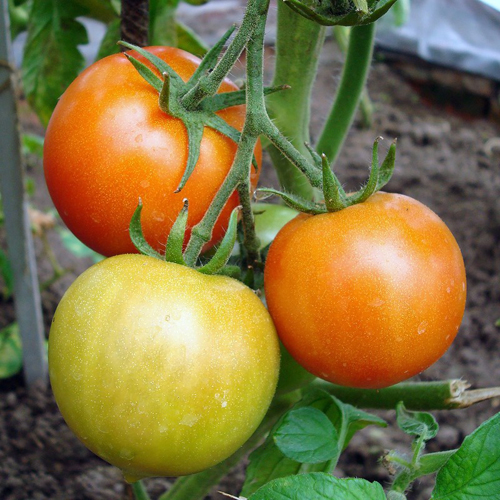Tomato variety Polbig (F1)
Getting a great harvest of tomatoes without bothering yourself too much - is it possible? Of course yes, if you find the right variety. Tomato Polbig belongs to the well-known Russian seed company Bejo Zaden B.V. Registration for admission of a novelty to cultivation took place in 2003, and in 2005 it was successfully entered into the State Register of Plants of the Russian Federation with permission for cultivation in all regions of Russia. Recommended for garden plots, home gardens and small farms. More suitable for open ground, but can be used for film shelters and greenhouses. Polbig is a hybrid, therefore the seeds are marked F1.

Description
The plant is determinate, powerful, bush type. Outdoors, the height is limited to 60 - 80 centimeters. In greenhouses, growth often overcomes the meter bar (1.3 meters). The root system of the variety is well developed. Moderate leafiness. Leaves are medium to large, light green to green in color. The arrangement of the leaves is alternate, the shape of the leaf plate is usual. Stem and shoots are slightly pubescent. The inflorescence is of a simple type. Polbig forms at least 4 clusters, each of which has 6 - 8 ovaries.
Tomatoes are very attractive in appearance, large - the State Register indicates an average weight of 105 to 135 grams, originators - from 180 to 200 grams. The largest fruits, as a rule, ripen on the first clusters. They are dense in consistency, flat-round in shape, slightly ribbed at the stalk. The skin is smooth, glossy, rather firm. In an unripe state, tomatoes of this variety are painted in a light green color, there is no spot at the stalk. The ripe ones are filled with bright red color. The color is uniform on the outside and inside. The pulp is fleshy, juicy, of good density. There are no veins and a core inside. The number of seed chambers is from 4 or more. The peduncle is articulated. The place of attachment of the stalk to the fruit is small. The taste of fresh tomatoes is very good, sweet and sour.

Characteristics
- The Polbig hybrid is valued for its early maturity, because from the moment of germination to the beginning of ripening, only 90 - 100 days pass. After planting seedlings in the southern regions, ripening begins already on the 58th day, in cooler ones - on the 60th - 65th. Due to early ripening, it is possible to use the culture for re-circulation;
- yield of marketable fruits - 5.7 kg per 1 square meter;
- the yield of mature marketable tomatoes - 80%;
- the variety is not afraid of late spring frosts, shows good setting at low temperatures. According to gardeners, at a very high temperature (about 40 ° C), the formation of the ovary is suspended;
- the plant's immunity is quite good, it is highly resistant to fusarium and verticillary wilting. Due to early ripening, it is not afraid of late blight;
- the dense skin protects the Polbiga fruits from cracking, thanks to which the crop can be transported over long distances;
- the keeping quality of tomatoes is also good - the taste and marketability remain up to 2 - 3 weeks;
- as a rule, the first wave of the harvest goes for fresh use, in salads. The second is for processing into tomato products (juices, pastes, lecho) and canning in pieces.
Agrotechnics
It is desirable to grow the variety in seedlings. Seeds are sown in March - April. The procedure for growing seedlings is standard. In the phase of two leaves, the plants dive, 2 - 3 weeks before planting in a permanent place, they are hardened. Plants are ready for planting in 50 - 55 days after full germination. Planting pattern - 40 cm between plants, row spacing about 50 cm wide. Allowable planting density - 7 - 9 bushes per 1 square meter.A few days after transplanting, the plant is tied to a support. In the open field, pinching is carried out up to the first fruit cluster. When closed, it is recommended to form 2 - 3 stems. Agricultural technology is standard for the culture as a whole.
The popular early ripe hybrid Polbig will not become a burden for the gardener, on the contrary, even a novice tomato lover can grow it. Good resistance to major diseases will help to grow an environmentally friendly product, yield will please with generosity, especially since the variety can be used in re-circulation. But, unfortunately, the seeds will have to be bought annually.








